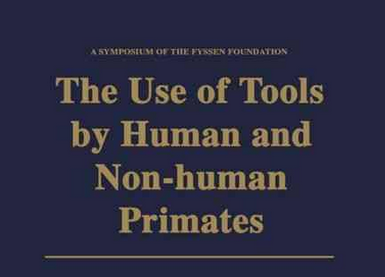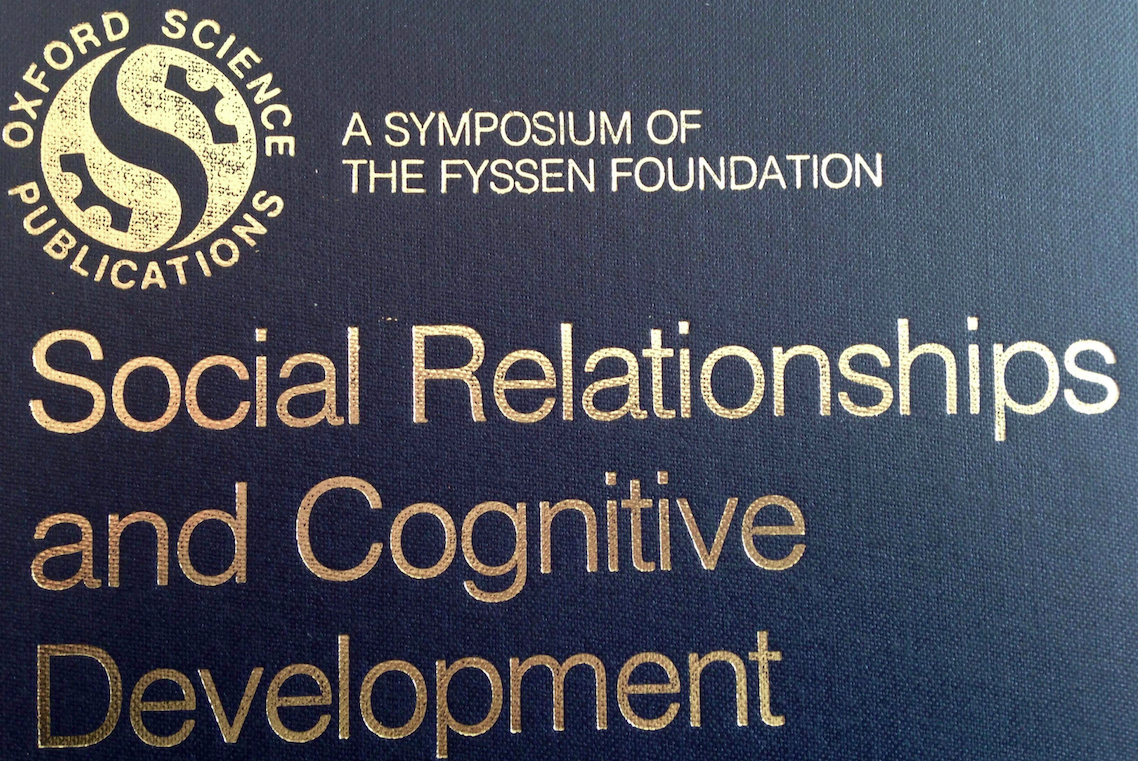-

-
The Use of Tools by Human and Non-Human Primates
29 novembre 1988Liste des participantsJames ANDERSON, Université Louis Pasteur, France
Kim BARD (contributor), Yerkes National Primate Research Center of Emory University, USA
Arlette Berthelet (co-editor), Laboratoire de Recherche sur l’Afrique Orientale, UPR 311-CNRS France
Sylvie BEYRIES (contributor), Centre de Recherches Archéologiques, ERA 28-CNRS, France
Pierre BODU, Laboratoire d’Ethnologie Prhéistorique, UA 275-CNRS, France
Christophe BOESCH (contributor), Universität Zurich-Irchel, Switzerland
Bernadette BRESARD (contributor), Laboratoire d’Ethologie, MNHN, France
Jean-Pierre CHANGEUX, Laboratoire de Neurobiologie Moléculaire, Institut Pasteur, France
Jean CHAVAILLON (chairman and co-editor)Laboratoire de Recherche sur l’Afrique Orientale, UPR 311-CNRS, France
Maurice GODELIER, EHESS, France
Jack HARRIS (contributor), Rutgers university, USA
Robert A. HINDE, Cambridge University, UK
Michel IMBERT, Laboratoire des neurosciences de la Vision, Université Pierre et Marie Curie, France
Tim INGOLD (contributor), University of Manchester, UK
Marc JEANNEROD, Laboratoire de Neuropsychologie Expérimentale, France
Françoise JOUFFROY (contributor), MNHN, France
Frédéric JOULIAN, France
Michelle JULIEN, Préhistoire des Andes, UPR 313-CNRS, France
Claudine KARLIN (contributor), Laboratoire d’Ethnologie Préhistorique, UA275-CNRS, France
Jean KITAHARA-FRISCH (contributor), Sophia University, Japan
J.D. LAJOUX, CNRS, France
Bruno LATOUR, Ecole Nationale Supérieure des Mines, France
Roger LEMON (contributor), University of Cambridge, UK
Pierre LEMONNIER, CNRS, France
William McGREW (contributor), University of Stirling, UK
Jacques PAILLARD (contributor), CNRS, France
Jacques PELEGRIN (contributor), CRA-CNRS, France
Catherine PERLES (contributor), CRA-CNRS, France
Jacques PERRIAULT (contributor), Ministère de l’Education Nationale, France
Pierre PETREQUIN (contributor), CNRS, France
Nicole PIGEOT, CNRS, France
Marcello PIPERNO (contributor), Museo Nazionale Preistorico Etnografico Luigi Pigorini, Italy
Sylvie PLOUX, CRA-CNRS, France
Pierre RABISCHONG (contributor), INSERM, France
Jean SAUBE, France
Pascal SELLIER, CNRS, Université de Bordeaux, France
François SIGAUT (contributor), EHESS, France
Yukimaru SUGIYAMA (contributor), Kyoto University, Japan
Boris VALENTIN, CNRS, France
Jacques VAUCLAIR, CNRS, France
Isabelle VILLEMEUR, CNRS, Université de BORDEAUX, France
Elisabetta VISALBERGHI (contributor), Istituto di Psicologia-CNR, ItalieThèmeOuvrage :
The Use of Tools by Human and Non-human Primates
A. Berthelet and J. ChavaillonAbstract
This volume brings together contributions on the theme of tools from international specialists in various disciplines — anatomists, neurobiologists, prehistorians, ethnologists, and primatologists — at a symposium arranged by the Fyssen Foundation. Tools, whether of stone, wood, or metal, are a prolongation of the arm, but they acquire precision through the hand directed by the brain. A movement may have been identical from one another, in apes and in humans, in the past and in the present, but the resulting action varies according to the extended use of the tool. It is therefore necessary to understand the origin of tools, and also to be able to describe the techniques of cutting tools, and to imagine the possible uses of certain tools. Comparison of the techniques of chimpanzees with those of prehistoric Man and of twentieth-century Man has made it possible to appreciate the common aspects and to identify the differences. The transmission of ability, and of the understanding also called apprenticeship, has been studied in the various relevant societies: chimpanzees in their natural habitat and in captivity, hunter-gatherers, and workmen in prehistoric and in modern times.
Keywords: anatomists, neurobiologists, prehistorians, ethnologists, primatologists, tool techniques, chimpanzees, ability transmission, prehistoric workmen, modern workmen
-

-
Social Relationships and Cognitive Development
16-20 Novembre 1984Liste des participantsJean-Louis ADRIEN, Service Pédopsychiatrie, C.H.R de Tours, France
Grazia ATTILI, Istituto di Psicologia del CNR, Italie
Monique BALLION, Institut National de Recherche Pédagogique, France
Bernadette BRESARD, Groupe de Recherche sur les Anthropoïdes, MNHN, France
Alain BROSSARD, Séminaire de Psychologie, Université de Neufchâtel, Switzerland
Peter E. BRYANT, Department of Experimental Psychology, University of Oxford, UK
Michael J.CHANDLER, Department of Psychology, University of British Columbia, Canada
Jean-Pierre CHANGEUX, Unité de Neurobiologie Moléculaire Institut Pasteur, France
Jean CHAVAILLON, Maître de Recherches, CNRS-5e circonscription, France
Dorothy CHENEY, Department of Anthropology, University of California, Los Angeles, USA
Verena DASSER, Zoologisches Institut, Universität Zurich-Irchel, Switzerland
Willem DOISE, Faculté de Psychologie et des Sciences de l’Education, Université de Genève, Switzerland
M. A.H. FYSSEN, Fondation Fyssen
Willard W. HARTUP, Institute of Child Development, University of Minnesota, USA
Robert A. HINDE, MRC Unit on the Development and Integration of Behaviour, Cambridge University, UK
Antonio LANNACONA, Istituto di Psicologia dell’Università di Salerno, Facoltà di Lettere, Italy
Nada IGNJATOVIC-SAVIC, Filozofski Fakulted, Cika Ljubina, Yugoslavia
Lothar KRAPPMANN, Max-Planck-Institut für Bildungsforschung, RFA
Helgard KREMIN, Laboratoire de Pathologie du Langage, Inserm U111, France
Hans KUMMER, Ethologie und Wildforschung, Universität Zurich-Irchel, Switzerland
Marie-Christine LACOUR, Etudiante en 3e cycle en Psycholinguistique à Paris VII option Ethologie, France
Bruno LATOUR, Maître de Recherches, ENS des Mines, Centre de Sociologie de l’Innovation, France
Alain LEGENDRE, Laboratoire de Psychobiologie de l’Enfant, France
Marie-Thérèse LENORMAND, Inserm U3, Pr. Scherrer, Hôpital de la Salpétrière, France
Anne-Nelly PERRET CLERMONT, Séminaire de Psychologie, Université de Neuchâtel, Switzerland
Jacques PERRIAULT, Directeur de Département, Institut National de Recherche Pédagogique, France
Marian RADKE-YARROW, Chief, Laboratory of Developmental Psychology, Department of Health and Human Services, National Institutes of Health, USA
Michel RUTTER, Department of Child and Adolescent, Psychiatry, Intitute of Psychiatry, UK
Robert L. SELMAN, Department of Psychiatry, Judge Baker Guidance Center, USA
Robert Seyfarth, Department of Anthropology, University of California, Los Angeles, USA
Tracy SHERMAN, Laboratory of Developmental Psychology, Department of Health and Human Services, National Institutes of Health, Maryland, USA
Myrna B. SHURE, Hahnemann University, Preventive Intervention Research Center, USA
Mira STAMBAK, Institut National de Recherche Pédagogique, France
Joan STEVENSON-HINDE, MRC unit on the Development and Integration of Behaviour, Cambridge University, UK
Serge STOLERU, Institut Universitaire des Sciences Psychosociales et Neurobiologiques, France
Barbara TIZARD, Thomas Coram Research Unit, UK
Jacques VAUCLAIR, Département de Pscyhologie Animale, CNRS-INP9, France
Lawrence WEISKRANTZ, Department of Experimental Psychology, university of Oxford, UK
James V.WERTSCH, Department of Linguistics, Northwestern University, College of Arts and Sciences, USAThèmeMost children grow up in a nuclear or extended family, interacting first with one or two parents, and then with siblings, with relations, and with friends, networks which constitute the most important part of the child’s environment. This volume considers the interplay between an individual’s social interactions and his cognitive development, tracing the effects on this interplay on children of a variety of ages, and discussing the role of conflict, the neo-Piagetian and Vygotskyan approaches, and therapies to increase social competence. The book demonstrates that cognitive development is closely related to other aspects of the individual, including emotions.
